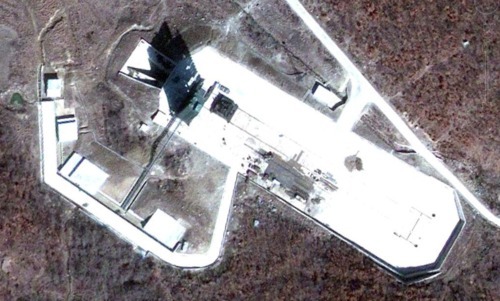 Google Earth image of launch pad from March 2009
Google Earth image of launch pad from March 2009
Now that North Korea has announced a window for a satellite launch in mid-April, I looked back at the timeline of events from its failed launch 3 years ago to see what to expect. Here’s what I found:
April 2009 launch timeline:
- Launch window: April 4-8, 2009
- Launch window announced on February 24: 39 days ahead of launch window
- Launch hazard zones at sea announced on March 12: 16 days ahead of launch window
- Launcher seen on launch pad on March 25: 10 days ahead of launch window
April 2012 launch timeline:
- Launch window: April 12-16, 2012
- Launch window announced on March 16: 27 days ahead of launch window
- 16 days ahead of launch window is March 27
- 10 days ahead of launch window is April 2
This suggests you would not expect to see a launcher in place until early April. In the meantime, you might see evidence of activity at the launch site.
Since photos of the launch site do not show a large building where the launch vehicle could be assembled and then moved to the launch tower, there seem to be two possibilities. One is that the launcher would be brought to the launch site in pieces and assembled on the launch pad; satellites should be able to see workers assembling the launcher in this case. Shortly before launch, the launch vehicle would be filled with fuel and oxidizer from storage tanks around the launch pad.
The other possibility is that the launch vehicle would be assembled somewhere else and then transported—without fuel—to the launch site, erected into a vertical position, and then moved into place at the tower. The fuel and oxidizer tanks would again be filled shortly before launch.
This possibility requires a trailer that could move the assembled launch vehicle to the site. I discussed such trailers in a recent post about reports of possible North Korean mobile long-range missiles. Those reports were apparently based on U.S. sightings of large trucks/trailers that might be used to transport large missiles. As I explained there, rockets as large as North Korea’s Unha launch vehicle can be moved on trailers (I show photos of China doing this with its DF-4 missile), but they are transported without fuel. Such trailers make rockets of this size movable, but not “mobile” in the typical sense that they can be moved into position and fired rapidly. Instead they require probably a couple hours to get into position and be fueled.
So maybe the trailers seen in North Korea were developed, at least in part, to move satellite launchers to its launch sites.
To see the Tongch’ang-dong launch site in Google Earth go to:
39 39.5’ N 124 42.3’ E
